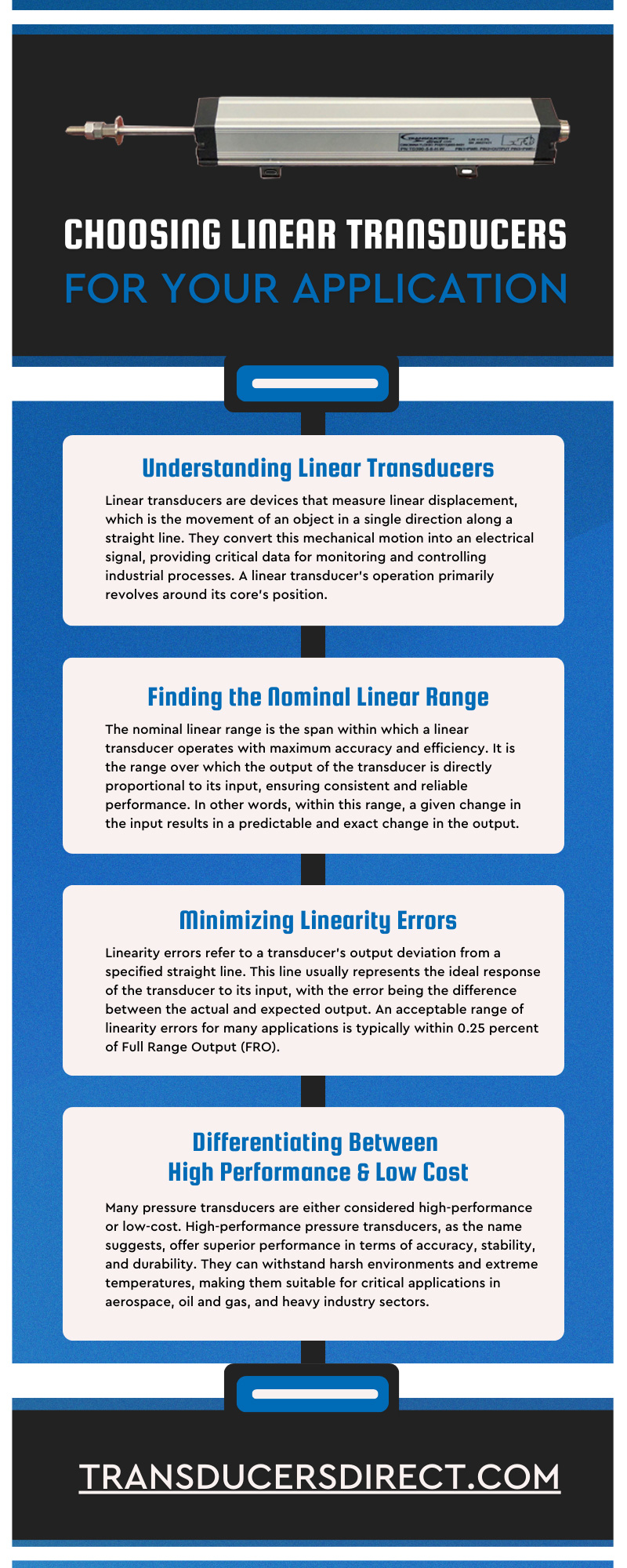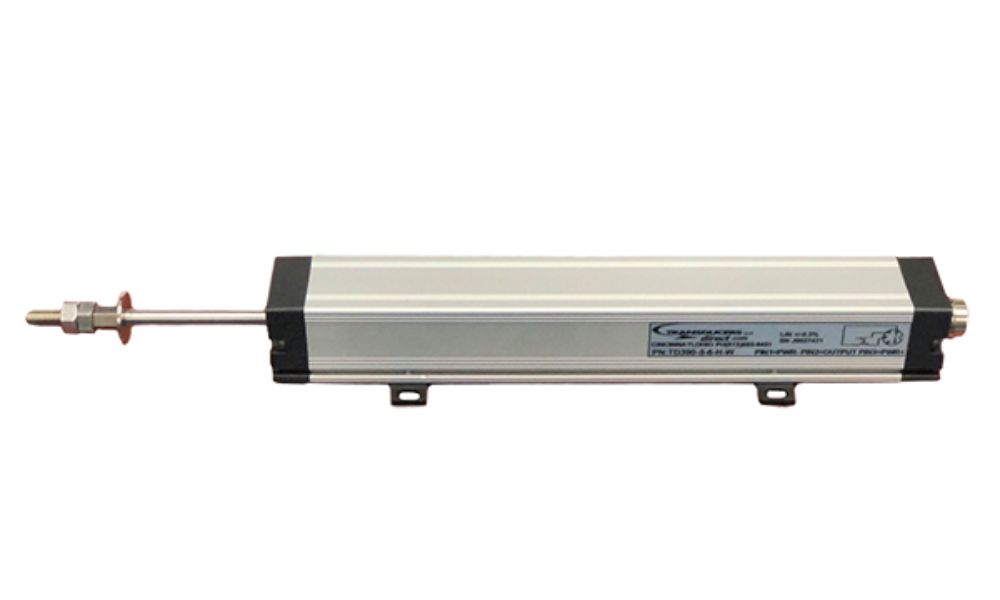Choosing Linear Transducers for Your Application

Linear transducers play a crucial role across a multitude of industrial applications, ranging from factory automation to plastic molding. These devices, which measure linear displacement along a single axis, convert this movement into signals, facilitating accurate, reliable, and absolute position feedback. With such a wide array of applications, selecting the linear transducer that caters to your specific industrial requirements is imperative.
Your choice of a suitable linear transducer can significantly influence the efficiency, precision, and overall performance of your industrial operations. Therefore, understanding the capabilities of these devices and their relevance in various industrial contexts is the first step toward making an informed decision. Read on to learn more about linear transducers and how to choose the ideal device for your application.
Understanding Linear Transducers
Linear transducers are devices that measure linear displacement, which is the movement of an object in a single direction along a straight line. They convert this mechanical motion into an electrical signal, providing critical data for monitoring and controlling industrial processes. A linear transducer’s operation primarily revolves around its core’s position. The core, usually a magnetically permeable material, moves within the coil assembly corresponding to the linear motion of the object under measurement. The change in position of the core modifies the magnetic field and alters the output signal, effectively translating the mechanical motion into an electrical representation.
Linear transducers find wide-ranging applications across various industries due to their versatility and precision. In robotics, for instance, linear transducers guide precise movements, enabling robots to execute complex tasks accurately. These devices also play a significant role in hydraulics, facilitating accurate control over hydraulic cylinders.
Diving deeper into the world of linear transducers, it’s important to understand the difference between AC and DC linear transducers. AC linear transducers, or alternating current transducers, work on the principle of mutual induction and require an external power source for their operation. They are largely immune to electrical noise, making them suitable for environments with high electrical interference.
On the other hand, DC linear transducers, or direct current transducers, operate based on the principle of self-induction. They do not require an external power source, which makes them a convenient choice for battery-operated or remote applications. However, they may be more susceptible to electrical noise compared to their AC counterparts. The choice between AC and DC linear transducers largely depends on the specific requirements of your application, including factors such as power availability, environmental conditions, and precision requirements.
Finding the Nominal Linear Range
The nominal linear range is the span within which a linear transducer operates with maximum accuracy and efficiency. It is the range over which the output of the transducer is directly proportional to its input, ensuring consistent and reliable performance. In other words, within this range, a given change in the input results in a predictable and exact change in the output.
For most applications, it is advisable to select a nominal linear range that is equal to or larger than the nominal value of the application. This ensures that the transducer can accurately measure all expected values, thereby enhancing its effectiveness and reliability. However, the extent of linearity required can vary based on the specific demands of your application.
In highly industrial applications, an accurate range is crucial for maintaining precise control over complex processes. Here, optimum linearity is often a non-negotiable requirement, as any deviation from the expected output can lead to significant operational issues.
On the other hand, there are applications where exceeding the optimum linearity may not necessarily impact performance. Therefore, it is essential to understand whether your application necessitates optimum linearity before determining the appropriate nominal linear range.
Minimizing Linearity Errors
Linearity errors refer to a transducer’s output deviation from a specified straight line. This line usually represents the ideal response of the transducer to its input, with the error being the difference between the actual and expected output. An acceptable range of linearity errors for many applications is typically within 0.25 percent of Full Range Output (FRO).
Certain applications, however, demand even higher precision. For these applications, onboard signal processing might be necessary. This advanced technique involves the use of sophisticated electronics integrated into the transducer itself. These electronics process the output signal in real time, correcting any deviations and ensuring a near-perfect linear response. Onboard signal processing can reduce linearity errors to as low as 0.05 percent of FRO.
Improving linearity errors is also possible by operating your linear transducers on less than full range or one side of null. Operating on less than full range means using the transducer within a limited portion of its total operational range. This approach can help improve linearity by avoiding the extreme ends of the range where non-linearity might be more pronounced.
Similarly, operating on one side of null means utilizing the transducer either above or below its zero point, thereby reducing the possibility of encountering linearity errors associated with crossing this point. These strategies can significantly enhance the accuracy of your measurements, leading to improved overall performance.
Recognizing Resolution & Repeatability
Resolution refers to the smallest change in input that a linear transducer can detect and convert into an output. It is a critical factor that determines the sensitivity and precision of a transducer. A high-resolution transducer can accurately detect even minute changes in input, leading to more precise and detailed measurements. This becomes particularly important in applications that require a high level of detail and accuracy, such as precision engineering and scientific research.
Repeatability, on the other hand, refers to the ability of a linear transducer to consistently reproduce the same output when exposed to the same input under identical conditions. Essentially, it gauges the consistency of a transducer’s performance over time. Good repeatability ensures that measurements remain reliable and trustworthy, regardless of how many times they are taken.
This characteristic is vital in industrial applications where continuous monitoring and control are necessary. Without high repeatability, it would be challenging to maintain stable and consistent operations, leading to potential inefficiencies and errors. Therefore, understanding the resolution and repeatability of linear transducers is pivotal in selecting the right device for your specific application.
Differentiating Between High Performance & Low Cost
Many pressure transducers are either considered high-performance or low-cost. High-performance pressure transducers, as the name suggests, offer superior performance in terms of accuracy, stability, and durability. They can withstand harsh environments and extreme temperatures, making them suitable for critical applications in aerospace, oil and gas, and heavy industry sectors. These transducers often come with advanced features like digital outputs and high-temperature capabilities.
On the other hand, low-cost devices, like potentiometric linear transducers, might not offer the same level of performance or durability. However, they do provide an affordable solution for less demanding applications. These devices are often used when cost is a significant factor, such as in HVAC systems, consumer appliances, and light industrial applications. Despite their lower price point, these transducers can still provide reliable repeatability within their specified range and conditions.
Choosing the right linear transducers for your application can significantly impact the performance and efficiency of your operations. Factors such as nominal linear range, linearity errors, resolution, and repeatability play a crucial role in determining the effectiveness of a linear transducer. By understanding these aspects, you can ensure that you choose a device that aligns with your specific needs.
Enhance your operations by equipping your workspace with industry-leading sensing devices. Explore our extensive selection of linear transducer products here at Transducers Direct, where quality meets innovation. Your journey toward improved operational accuracy and efficiency begins with us.




Leave A Comment